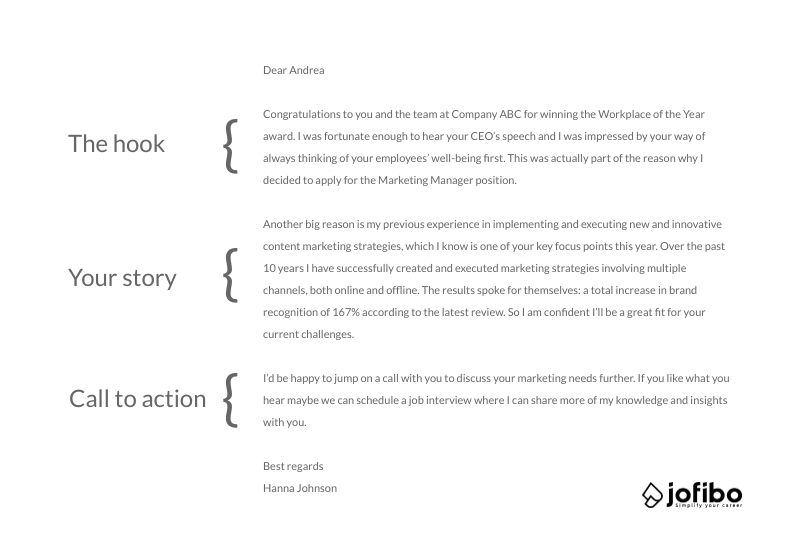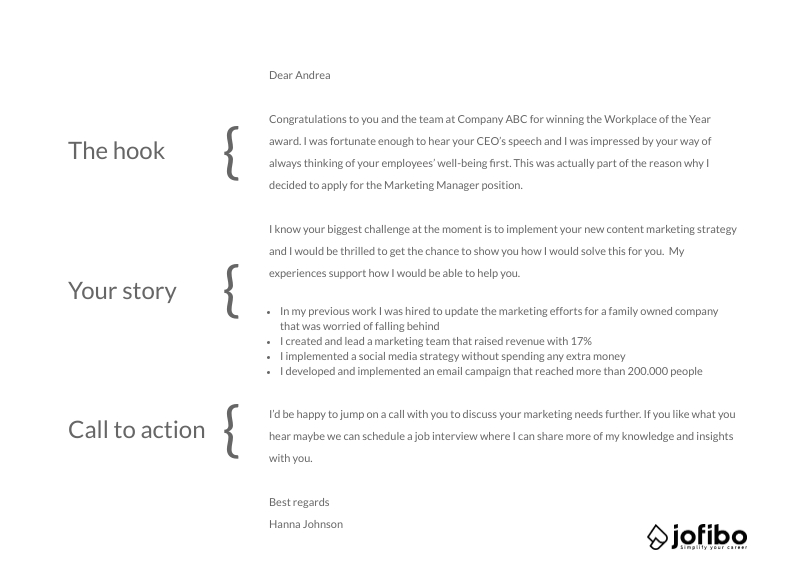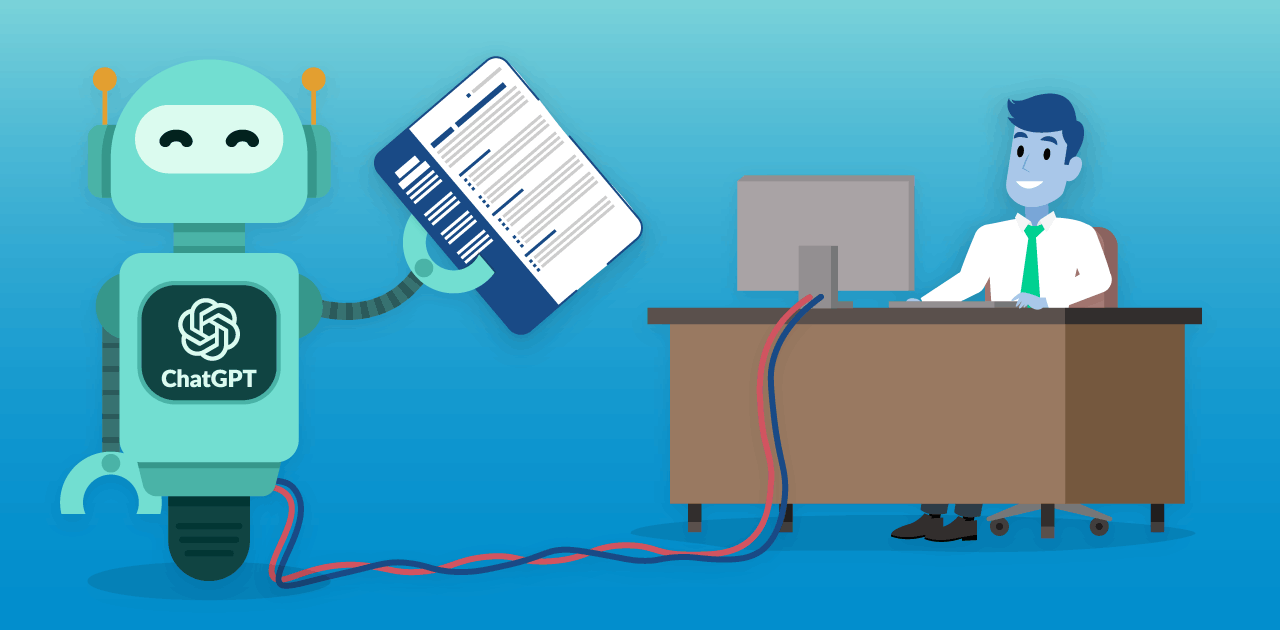How to Write a Pain Letter [Examples]
![How to Write a Pain Letter [Examples]](https://jofibostorage.blob.core.windows.net/blog/Painletter-small.jpg)
“Job search is broken. The classic approaches just don’t work anymore.” Have you ever had these thoughts? And have you ever thought of an alternative job search strategy?
Introducing pain letters - the secret weapon in your job search. Also known as pain cover letters.
The secret to the pain letter lies in the instant connection you make with your potential new boss. It involves breaking the HR rules a little bit but most recruiters and managers will welcome this break.
This article will cover the following topics:
- What is a pain letter?
- How to write a pain letter - tips and tricks
- 3 ways to do research for a pain letter
- Do pain letters work?
- Pain letter examples
Let’s start from the beginning: what is a pain letter?
What is a pain letter?
Basically, a pain letter is a cover letter on speed. It has more than ten times the probability to get you a job interview than your average standard cover letter.
Instead of the generic “I’m applying to position xx because…” the pain letter will show the recipient exactly how you plan to solve their pain by using your skills and professional experiences.
How to write a pain letter
A pain letter consists of three elements (besides of course the formal necessities of a business letter such as contact info).
- A hook to get your reader, well.. hooked
- Your story (how will you ease their pain?)
- Your call to action
Let’s walk you through the whole process, step by step.
The hook
This is where you grab your reader’s attention. The goal is to get her so hooked that she keeps on reading. The secret ingredient here is to make it all about them. Find a recent win (within the past six months) by the employer that you can use. It could be an award, a successful implementation of a new strategy, a recent keynote speak, or something else that is relevant.
An example could be:
“Dear Andrea
Congratulations to you and the team at Company ABC for winning the Workplace of the Year award. I was fortunate enough to hear your CEO’s speech and I was impressed by your way of always thinking of your employees’ well-being first. This was actually part of the reason why I decided to apply for the Marketing Manager position.“
This will definitely grab Andrea’s attention.
Employer’s pain and your story
Next up is the employer’s pain and your story of how you’ll help them overcome it. First of all you’ll need to identify the employer’s pain - the problem. Here’s how it goes:
Problem → Solution → Impact
In just one short paragraph, you’ll need to describe the problem, the solution, and the impact. Here’s how you do it.
Read through the job ad and identify the main issues the company is facing. They will typically hide in plain sight in the job description. Look for phrases such as “We are seeking…” or “Our company needs someone to…” For instance this could be:
“We are seeking the perfect candidate to help us implement a new marketing strategy to increase our overall brand recognition.”
This is the pain you’ll need to address in your pain letter.
Alternatively, if the pain is not described directly, seek out the company’s about page, check out their social media accounts, or do an online search for any articles that may have been written about them lately. This can point you in the right direction.
Now you need to tell them how you intend to solve their pain. Think back on a time when you faced a similar problem and overcame it. Use your skills and past experiences to describe how your contribution will make an impact. Like this:
“Another big reason is my previous experience in implementing and executing new and innovative content marketing strategies, which I know is one of your key focus points this year. Over the past 10 years I have successfully created and executed marketing strategies involving multiple channels, both online and offline. The results spoke for themselves: a total increase in brand recognition of 167% according to the latest review. So I am confident I’ll be a great fit for your current challenges.”
This is your story. Tell it. Let your human voice shine through it and reach into the hiring managers mind.
Call to action
Lastly in your pain letter you should add a call to action - a strong finish to your pain letter. It isn’t as hard as it might seem. Basically, this is where you close the deal. The deal being to get an interview. Your call to action (CTA) paragraph could look something like this:
“I’d be happy to jump on a call with you to discuss your marketing needs further. If you like what you hear maybe we can schedule a job interview where I can share more of my knowledge and insights with you.”
Finish it all off with a friendly sign off and your name. That’s it.
Not ready to write your own pain letter yet? Read on for more tips and tricks to create the perfect pain letter.
3 ways to do research for a pain letter
In order to create a compelling pain letter you probably need to do some research. First of all you need to find the company’s pain points. One way of doing this is simply by calling the hiring manager and ask her what their biggest challenge is at the moment.
Call her up and ask questions such as:
- Who is your perfect candidate for the position?
- What is your biggest challenge at the moment?
- Which goals are you aiming to reach within the next six months?
And then you build your pain letter from here.
Another strategy is to reach out to employees at the company in question. Here’s how you succeed with this:
- Open Linkedin and search the company
- Reach out to employees (connect with them, send a message or an email)
- Ask for a short call or ask them if it’s okay you send them a couple of questions
Write your pain letter from your results.
Your third option is to go online and do a regular internet search on the company. Look for:
- About pages
- Press releases
- Recent news articles regarding the company
- Other interesting finds involving the company executives
Your goal is to find the company’s challenges. Then build your pain letter from there.
Do pain letters work?
Pain letters do work. But make sure you do your research right. Don’t just assume you’ve found the company’s pain points. Make sure they are in fact correct. Worst case scenario is that you annoy the recruiter and you risk to come across as uninformed. On the other hand, the best case scenario is that you nail it and really impress the recruiter.
To maximize the outcome of your pain letter, you can consider taking these steps:
- Do your research thoroughly
- Never assume you know the exact pain points of a company
- Be humble and grateful if you approach someone in the company
- Send the pain letter electronically - preferably directly to the hiring manager
If conducted well, the pain letter will transform you from a generic Jane to someone the hiring manager MUST talk to.
Pain letter examples
Below we’ve added some pain letter examples for your inspiration.

Pain letter text version 1 you can copy
Dear Andrea
Congratulations to you and the team at Company ABC for winning the Workplace of the Year award. I was fortunate enough to hear your CEO’s speech and I was impressed by your way of always thinking of your employees’ well-being first. This was actually part of the reason why I decided to apply for the Marketing Manager position.
Another big reason is my previous experience in implementing and executing new and innovative content marketing strategies, which I know is one of your key focus points this year. Over the past 10 years I have successfully created and executed marketing strategies involving multiple channels, both online and offline. The results spoke for themselves: a total increase in brand recognition of 167% according to the latest review. So I am confident I’ll be a great fit for your current challenges.
I’d be happy to jump on a call with you to discuss your marketing needs further. If you like what you hear maybe we can schedule a job interview where I can share more of my knowledge and insights with you.
Best regards
Hanna Johnson
Sometimes you haven’t solved the exact problem the company is facing. That’s okay! Here’s what you do instead:
- Find your hook
- Note down three achievements you’ve done in the past
- Put them in relation to the company’s pain
- Finish with your call to action

Pain letter text version 2 you can copy
Dear Andrea
Congratulations to you and the team at Company ABC for winning the Workplace of the Year award. I was fortunate enough to hear your CEO’s speech and I was impressed by your way of always thinking of your employees’ well-being first. This was actually part of the reason why I decided to apply for the Marketing Manager position.
I know your biggest challenge at the moment is to implement your new content marketing strategy and I would be thrilled to get the chance to show you how I would solve this for you. My experiences support how I would be able to help you.
In my previous work I was hired to update the marketing efforts for a family owned company that was worried of falling behind
I created and lead a marketing team that raised revenue with 17%
I implemented a social media strategy without spending any extra money
I developed and implemented an email campaign that reached more than 200.000 people
I’d be happy to jump on a call with you to discuss your marketing needs further. If you like what you hear maybe we can schedule a job interview where I can share more of my knowledge and insights with you.
Best regards
Hanna Johnson
Pain letter takeaways
- Always do your research thoroughly
- Find the email address and name of the recruiter or hiring manager
- Pinpoint the company’s main pains and build your pain letter from that
- Create a great hook and grab the recruiter’s attention
- Create a compelling story where you relate your experiences to the company’s pain
- Make sure you have a call to action sentence at the end of your pain letter
- Stay humble and be grateful if you reach out to someone from the company
Are you ready to create your own pain letter as an alternative cover letter?
![Marketing Manager Resume Example & Guide [2025]](https://jofibostorage.blob.core.windows.net/blog/marketing-manager-example-top.jpg)
![Biodata Resume Format [Guide & Examples]](https://jofibostorage.blob.core.windows.net/blog/Biodata-format-small.jpg)

